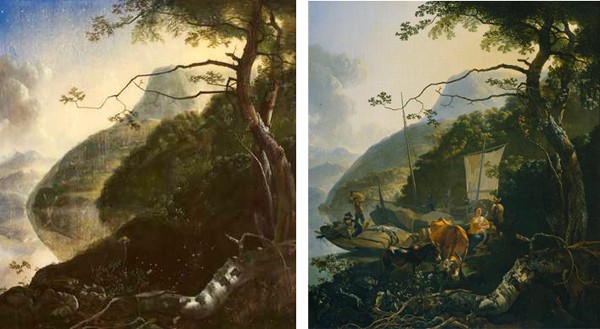
Pick this year’s model and the Adam Pynacker 1660 version. One is an officially sanctioned Australian landscape.
.
The sound of embarrassment and protesting too much
Do you know the sound of embarrassment? It’s the soundtrack to this year’s art controversy. It accompanies the current comedy of the Wynne prize, which is awarded annually for “the best landscape painting of Australian scenery in oils or watercolours or for the best example of figure sculpture by Australian artists completed during the 12 months preceding the [closing] date …”
It sounds like this:
The AGNSW’s director, Edmund Capon: “When the picture came up … they [the judges] all thought: ‘What a wonderful painting – it looks like a late 17th-century Dutch landscape.’ And that was my first instinct. So what?”
And in the sound of the phrase “not sort of”, as in:
”There are some key differences there,” artist Sam Leach said. ”Quite clearly I’m quoting that original work … I’m not sort of ashamed or worried about it.”
It’s, er, hard to say … and hard to know:
Had the judges known how closely the painting reassembled Pynacker’s work – held at the Rijksmuseum in Amsterdam – would they have given Leach the prize?
”This is always hard to say,” she [artist and prize judge, Lindy Lee] said, adding that having so many judges made it hard to know.
Even not when it comes down to the final:
She went on: “‘We have to view 1800 paintings. We are not going to discuss the historical traditions and the lineage of each painting, and even not when it comes down to the final two or three.”
A very interesting question about originality and uniqueness … whatever:
The artist: “Anything you do in the Archibald and Wynne, somebody’s going to call it embarrassing for you. And so OK, fine, whatever. This is not embarrassing … I think it’s a very interesting question about originality and uniqueness and what makes something authentic.”
The myth, the wonder, the beauty:
Another judge, artist John Beard, defended Leach’s award with vigour, despite not sighting the original. “What matters is when I looked at it I felt the myth, the wonder, the beauty,” he said.
Oh, only a problem in an academic context (the P word, and more than a coincidence):
Art academics said if Leach submitted his work for academic assessment without attribution, he would be accused of plagiarism. Ted Snell, the chair of the visual arts board of the Australia Council and The Australian’s Perth visual arts critic, said the painting would have posed difficulties in an academic context.
“Well there is more than a coincidence here, and without the tell-tale Dutch boatmen and the suckling mother and a few bony cows, it would be hard to tell the works apart,” Professor Snell said. “In an academic environment, this form of citation would be acceptable if fully acknowledged, but without referencing the original, it runs very close to breaching ethical practice.”
+++
So next year it will be fine to enter these paintings. Go for it folks:
These are called “Mentone Holiday,” “Balcony 3”, “Fire’s Out” and “Post-Pioneer.” They “reference” other landscapes – Australian ones – with, oh, many detail differences not to mention scale etc etc. The originals being referenced are below.
Let’s keep in mind what gallery director Mr Capon said: ”It’s not a copy. There’s vast differences in detail, apart from the fact that the scale is somewhat different.”
And so, basically: As Sydney Morning Herald art critic, John McDonald – who said Leech’s* painting was “basically a copy” of Pynacker’s canvas with minor changes – pointed out: now, “anyone can enter something which can win which is basically a copy of another person’s painting, or indeed is not even an Australian subject.”
(*sic: Fairfax‘s hilarious Freudian spelling slip of Leach’s name.)
.
MENTONE HOLIDAY

.
BALCONY 3
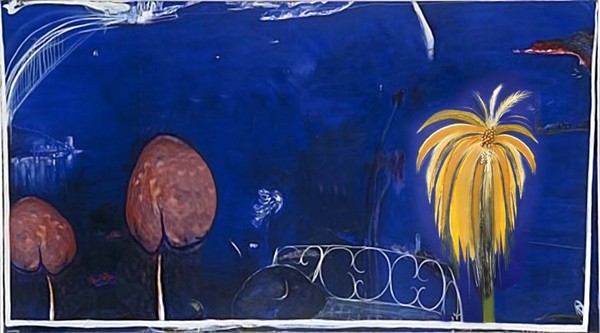
.
FIRE’S OUT
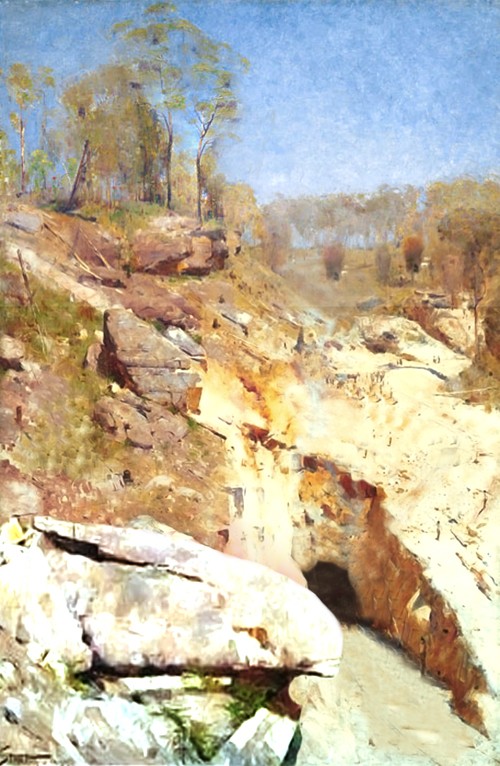
.
POST-PIONEER
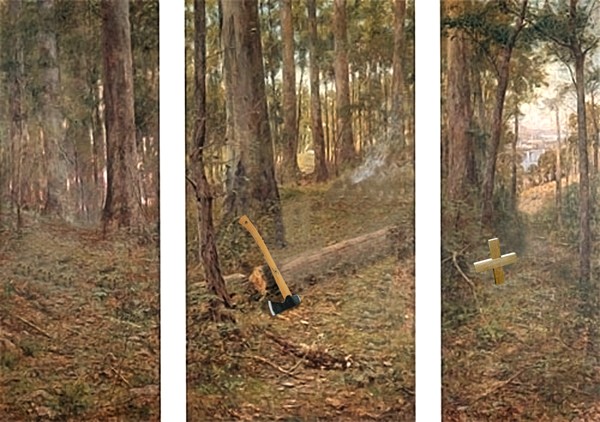
+++
Mere references:
Charles Conder’s A Holiday at Mentone; Brett Whileteley’s The Balcony 2; Arthur Streeton’s Fire’s On; Frederick McCubbin’s The Pioneers.
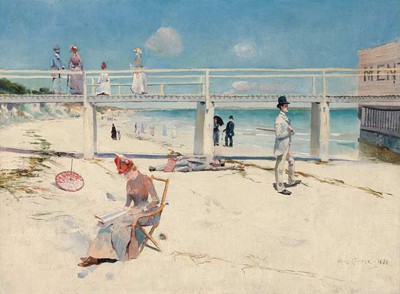

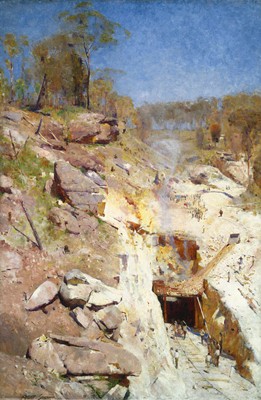

+++
My tuppence:
Let me say that I like Mr Leach’s Proposal for a Lansdscaped Cosmos quite a lot. His painting style – smooth, often photographically seamless – has a perfectionism that can be very appealing. I thought so when I first saw a reproduction of his Wynner online.
But in light of the Wynne requirements and seeing the Pynacker original, I think that the judges should receive a fail in art history, and a fail in retrospective judgement, and a fail in humility. I still like the painting, but clearly it shouldn’t retain the prize.
A great part of a painting’s work is in composition, conception, and yes, originality. There are some very fine copies of famous works by other famous artists, but they are for the sake of learning from a master, and do not pretend to be anything else. Many of the arguments above sound tinny to me – it sets off the old bullshit meter. The naked emperors are saving face.
There are dirty words no one can bear to bring up. As an architect friend of mine remarks, We say edit, we don’t say plagiarize.
So today, children, we say reference, we don’t say r*p-*ff.
Amusing side note:
In an AGNSW video interview between Sam Leach and Edmund Capon, Capon introduces the artist thus:
“Sam, you have well and truly inscribed yourself into the anals of Australian art history.” Indeed.
+++
UPDATE: 28 April 2010
In a board meeting the Trustees of the Art Gallery of NSW have decided that Sam Leach should keep his prize. Director Edmund Capon said, “‘It wasn’t taken lightly. I don’t think we have ever spent an hour at a board meeting discussing a topic in this way.”
In a written statement, the trustees defended their decision, saying that at the time of judging they noted that Leach’s painting had ”the light and air of a Dutch 17th-century painting”, but they also ”recognised and appreciated its quality and its mysterious implications of the natural world”.
The trustees concluded that ”what might constitute an Australian landscape was a matter of interpretation and had changed enormously since the Wynne Prize was first awarded in 1897.”
The artist said: ”I made this painting with total sincerity and a great deal of thought. I believed it makes an interesting contribution to the history and discourse of Australian landscape painting.”








Crikey is committed to hosting lively discussions. Help us keep the conversation useful, interesting and welcoming. We aim to publish comments quickly in the interest of promoting robust conversation, but we’re a small team and we deploy filters to protect against legal risk. Occasionally your comment may be held up while we review, but we’re working as fast as we can to keep the conversation rolling.
The Crikey comment section is members-only content. Please subscribe to leave a comment.
The Crikey comment section is members-only content. Please login to leave a comment.